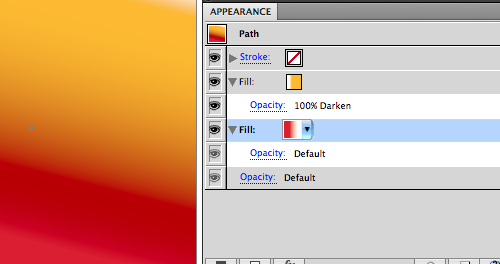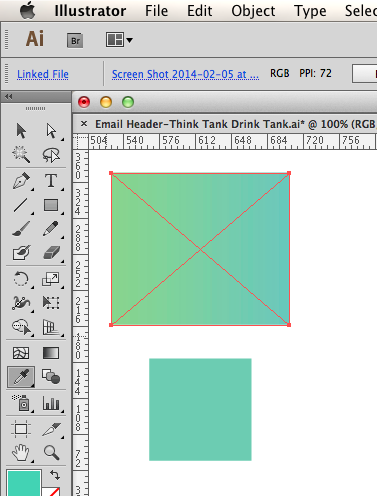- Home
- Illustrator
- Discussions
- Re: How do I mix 2 pms colors to achieve a 3rd col...
- Re: How do I mix 2 pms colors to achieve a 3rd col...
How do I mix 2 pms colors to achieve a 3rd color?
Copy link to clipboard
Copied
I'm running Illustrator CS6 on a Win 64 bit PC. Seems there was a time, in earlier versions when I could pick a pms blue and a pms yellow and achieve a rudimentary green by mixing 20% pms blue and 60% pms yellow, as an example.
I'm having a whale of a time figuring out to do this in the current version. I've been futzing around in edit/edit colors using the two pms colors I've chosen and although I can get tints of each color I can't seem to figure out how to get blends of the tints of each color.
Can anyone help out there? Please?
Explore related tutorials & articles
Copy link to clipboard
Copied
You are mis-remembering. Illustrator has never had a mixed ink ability. You may be thinking of Indesign.
In Illustrator, the easiest way is to use the Appearance Panel with multiple fills and overprint settings, then turn on Overprint Preview for the document.
Copy link to clipboard
Copied
Mis-remembering -- that's a nice way to put it to a guy who just hit 60.
I got it now. Thanks.
Copy link to clipboard
Copied
Hey, I mis-remember all the time ![]()
Copy link to clipboard
Copied
And I can't even remember the last time I mis-remembered 🙂
Alzheimer-Light.
Copy link to clipboard
Copied
The best you can do is to use Overprint on one of the colours and have Overprint Preview turned on.
That way you can put one colour on top of the other like you describe.
You can't make swatches of mixtures like this though.
On the other hand you CAN make gradients between spot colours but they will revert to CMYK blends when expanded.
The other trick is to work in faux colours using, for example, magenta for spot red and cyan for spot blue.
You will of course not get an accurate preview but the plates will be o.k. and working is much simpler than when using spots. Printing will also be o.k. as long as you work in close co-operation with your printer.
Copy link to clipboard
Copied
I remember making a document about this (and I am over 60 ![]() ). It describes how to simulate mixed inks in Illustrator and how to create and modify a mixed inks Graphic Styles library.
). It describes how to simulate mixed inks in Illustrator and how to create and modify a mixed inks Graphic Styles library.
I have to update it for CS6 (new screendumps), but the process works in older versions. Included in the PDF is a graphic styles library if you feel lazy.
Here is the link to the document:
https://creative.adobe.com/file/6db88ce1-64f8-4e60-a2d2-ef4a92d7c4de
Ton
Copy link to clipboard
Copied
Yep, this is basically the overprint method that I described and it assumes that whole objects need to be filled with a mix of two spots. O.k. as far as it goes, although I imagined the process rather in terms of 2 objects partially overlapping, each in its own spot colour. (And I'm way past 60 too ![]() .)
.)
Copy link to clipboard
Copied
So this seems to be an "over 60" subject. I guess anyone younger designs for web, phones and tablets and could not care less ![]() .
.
That is not true of course, I see many beautiful posters done with a limited amount of colours.
I do not understand your remark: "On the other hand you CAN make gradients between spot colours but they will revert to CMYK blends when expanded."
Why would you expand them? They separate perfectly for print without expanding. You can keep the spot colours even when you rasterize the blended object.
Copy link to clipboard
Copied
No reason to expand the spot color gradient they separate fine.
The explanation about overprint and it being an older persons tool is that many younger professionals are not taught production, the idea of overprint is totally foreign to them amongst other production wise work flow.
There are users in their forties that have production experience. That does not mean all young people are ignorant of their craft but it is less of an issue for them as other people take up the slack.
We see it all the time on the forum, unusual things like users not converting RGB image files to cmyk in photoshop before placing them into an Illustrator file nd wondering why the color is off.
They often confuse dpi for ppi. the do not know the difference between spot colors and process color equivalent, don't know the difference between vector and raster! the list goes on.
They don't understand why you can't overprint to cmyk process colors.
There aree really an interesting lack of apprentiship in the filed these days.
However even the less eexperience do know heir trade as it is today and oftebn surprise us with interesting techniques and knowledge of software and hardware issues.
They say you are as young as you feel and i don't feel a day over 67 which is amazing since i am 67. I guess all that expercise has paid off. I am really tired.
Copy link to clipboard
Copied
I do not understand your remark: "On the other hand you CAN make gradients between spot colours but they will revert to CMYK blends when expanded."
I was merely pointing out that you cannot make a spot swatch of an in-between stop in a spot-to-spot gradient.
Expanding the gradient won't help either because the in-between steps will be CMYK mixtures.
Copy link to clipboard
Copied
Hi Ton,
I was able to find your "Mixed_spots_inks.pdf" but it's from the CS2 version:
http://www.adobe.com/nl/pdfs/Mixed_spots_inks.pdf
The link you provided above for the CS6 updated version si not working.
Would you mind providing it again? Your input is awesome.
Thank you so much!!
Karla
Copy link to clipboard
Copied
Karla,
I wonder why the link stopped working, but here it is again:
https://creative.adobe.com/share/62c88061-d752-4843-8879-258bbe2876d2
Actually I updated it for CS5, but the method is the same.
regards,
Ton
Copy link to clipboard
Copied
I want to add my 2 cents about mixing spot colors. The screen angle of spot colors is usually the same as either the cyan or black separation for conventional (offset) printing. This works well as long as the spot color does not overprint either the cyan or black or another spot color, otherwise you will see an unwanted pattern, or have other issues. An alert printer will adjust the 2nd spot color screen angle, or use stochastic screening to avoid problems. This only applies to screened ink (less than solid areas) and is something for the printer to worry about, not the designer, but it's something to look for on the press proof. If you substitute CMYK for your spot colors, as Steve pointed out in post #2, you will also avoid two inks printing on the same angle.
Copy link to clipboard
Copied
I used attributes before tranparency blending modes. The appearance panel allows me to keep this all in one object for cleaner editing You can use multiply or darken with spots. I use darken instead of multiply, because our color laser proofs look more accurate – separations would be the same since the inks are spot.

In the screenshot, am overlapping inks in the middle over the gradient with over 100% totol ink, so that the middle part does not look weak and washed out.

Copy link to clipboard
Copied
I found a quick and dirty workaround to combining two colors to create a new color in Illustrator.
1. Create a gradient of the two colors you want to blend
2. Take a screenshot of the gradient
3. Place that screenshot image in your working AI doc
4. Using the eyedropper tool, select a color in the middle of the gradient until you find one that you like
It’s by no means exact, but it’s super quick and easy.


Copy link to clipboard
Copied
Hi ButterUpButtercup,
this thread is about mixing 2 Pantone colours and keeping the spot colours when separating/printing the file.
Your workaround is about creating a single new colour from a mix of two colours, so the spotcolour information will get lost.
But if that is not important (because you want to work for screens, or if you do not care about spot inks but just want the colour impression), there may be an even easier way.
1. Create a gradient of the two colors you want to blend
2. Select Object > Expand, specify the number of objects to expand the gradient to.
3. While they are still selected, go to the Swatches Panel and select Add Selected Colours from the fly-out menu.
You can then select them from the Swatches panel (and as a bonus they are Global colours).

Copy link to clipboard
Copied
Hi Ton and Steve,
Thank you both for the feedback. I apologize that I misunderstood the thread topic. I was looking for an easy way to create a new color from two blended colors and wanted to share my solution. I was creating graphics for an email and therefore only working in RGB/for the screen—I should have specified that.
Ton, thanks for sharing your easier way!
Copy link to clipboard
Copied
No problem ButterUpButtercup.
Good to hear you could use it.
regards,
Ton
Copy link to clipboard
Copied
Woah! This is exactly the way not to go.
Firstly by using a screen shot you are converting to RGB, so you need careful colour management to convert back to CMYK.
Secondly, as Ton points out, the outcome will never be a spot colour. Only a CMYK mixture.
(A better way to get a reasonable CMYK mix is to do a 1 step blend between the 2 spot colours and then expand or use the Eyedropper.)
But the fact still remains that a mixture of 2 spot colours will never produce a single spot colour.
That’s why I suggested the Overprint method in the beginning.
Think of the problem in terms of physical printing inks. If you want to keep to 2 inks, the only way you can produce other colours is by mixing those 2 inks.



